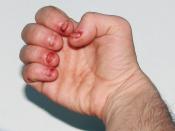Outline and explain some theories and treatments of Obsessive-compulsive disorder.
Obsessive-compulsive disorder (OCD) is an anxiety disorder that is notoriously difficult to treat. It is thought that around 2% of the population suffer from the condition and its often-devastating consequences. There are many very different approaches to understanding it and to treating it.
Most sufferers are completely aware of the problem, viewing their compulsions as rather silly or absurd. They are also aware that symptoms belong to themselves in a way that sufferers of, for example, schizophrenia, are not. Although there is no pleasure associated with the obsessions or compulsions, as there might be from over eating or gambling, and they can often lead to relationship problems as the family and friends of the suffer struggle to deal with the patients behaviour, not to mention the huge portions of the day it can take up going through these rituals, individuals continue to pursue them though they are not useful in any way.
Obsessions, or uncontrollable recurring thoughts, can come in many forms including obsessive doubts, obsessive fears, and obsessive images. An example describes the case of a 28-year-old man with an obsess ional fear of harming others, who would not drive his car because the fear of running someone down was too great.
The other component of the disorder, compulsions, are defined as acts which an individual feels an uncontrollable need to repeat over and over again, as a woman with a fear of being contaminated by dogs. She associated entire areas with dogs and just hearing one of the place names caused her to begin washing rituals. Often compulsions have to do with cleanliness and orderliness, and include yielding compulsions and controlling compulsions.
The theories and treatments of OCD are very varied, with many different approaches. The behavioural theory...



Opinion
A very useful and detailed essay.
0 out of 0 people found this comment useful.